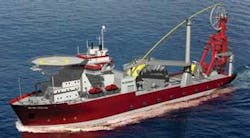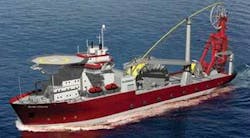Weight-distributed steel catenary risers a harsh environment plus
Daniel Karunakaran, Subsea7
Advantages to applying a weight-distributed concept to steel catenary risers in a harsh environment are developed in a new design by Subsea7 with Statoil participation.
Steel catenary risers (SCR) have become an attractive choice for deepwater field developments. However, the application of SCRs from semisubmersible floating production units (FPU) in deepwater harsh environments presents design challenges, due to the large wave-induced motions on the platform, and large vessel offsets caused by wind, current, and slow-drift wave motions. There also are buckling issues at the touch down point (TDP) caused by large heave and surge motions, and fatigue problems due to vessel motions and soil-riser interaction.
Subsea7, with active assistance from Statoil, addresses these problems in its new weight-distributed SCR concept, which involves varying weight along the riser, with the lightest possible cross-sections in the Touch Down Zone (TDZ). This concept is schematically shown in Figure 1. The variation in weight of the riser is achieved by applying different density coatings. The concept uses available materials and technology.
Heavy weight sections can be made from already qualified weight coating. During Norway’s Demo2000 project, Ti-Rise - the Vikoweight coating from Trelleborg Viking - was qualified for offshore use through an extensive testing program. Vikoweight is a rubber-based weight coating with a density equal to 3000 kg/cu m.
The lightweight cross sections can be assembled by applying low-density insulation coatings. There are different methods for achieving low-density coating, and usually a multi-layer technology is applied to best fulfill the various functional requirements.
Thermal conductivity of a generic material is linked directly to the material’s density, and different low-density materials are tested by coating suppliers. The project readiness of various materials for deepwater application differ, however Soco-Ril’s five-layer syntactic PP coating has been used in the Roncador project at 2,000-m water depth and the Bonga project at 1,200-m water depth. Pipe dimensions installed range from 8-12 in., with coating thickness ranging from 34-102 mm. The coating density for Bonga was 680 kg/cu m with an OHTC (overall heat transfer coefficient) of 2.2 W/m°K. Typical application with five-layer syntactic PP coating, and weight density of 650 kg/cu m, is shown in Figure 2.
This concept has been demonstrated for three riser applications for 1,000-m waters in North Sea conditions. By varying the weights along the riser, SCRs have been designed to serve as 10-in. and 12-in. production risers, and a 24-in. gas export risers from a semisubmersible platform.
As shown schematically in Figure 1, a feasible riser configuration can be achieved by varying the weight along the riser length. For deepwater SCRs, the key design issues are local buckling and severe fatigue damage at TDZ. Heavy stresses at TDZ are due to the “compression waves” induced by vessel motions, and also the up and down motion of long riser sections at TDZ. Further, in harsh environments the wave and vessel motion-induced dynamics of the straight section of the SCR also influence the stresses at TDZ.
Hence, a feasible configuration can be obtained only by controlling the dynamic stresses at TDZ. The features of the riser design are:
- Lightest possible cross-section at TDZ. This helps reduce the propagation of compression waves from vessel heave motion. Also, it reduces the dynamic stresses at TDZ caused by the up and down movement of long riser sections at TDZ
- Heavy riser cross-section on the straight part of the SCR. This reduces the dynamics of the straight section, lessening the dynamic stresses at TDZ. However, for deepwater applications this also increases both the hang-off loads and the dynamic axial stress closer to the hang-off.
Subsea7 thoroughly investigated the developed riser configurations for North Sea extreme wave and current conditions. A full and comprehensive fatigue analysis also was performed for wave dynamics and vortex-induced vibration (VIV) dynamics.
Behavior of the weight-distributed SCR at TDZ is compared to that of a standard SCR for the North Sea extreme condition in Figure 3. The standard SCR is highlighted in red at TDZ, whereas the weight-distributed SCR is shown in yellow and blue. It is clear that the bending behavior of the weight-distributed SCR is smooth and mild compared to the standard SCR. As indicated, stresses on the weight-distributed SCR are almost a third of normal SCR. This clearly shows the advantage of this concept.
Further, for all riser sizes, the weight-distributed SCR concept has a fatigue life four to five times longer than the required fatigue life. And the fatigue life is not sensitive to uncertain input parameters such as soil-riser interaction, which makes the design very robust.
The following conclusions can be drawn from the above discussions:
- Robust design of SCRs for harsh environment from large motion FPUs is possible by applying weight optimized risers. Weight optimization is achieved by qualified and readily available coatings within their tested and qualified density and thickness limits
- Sufficient fatigue life is achieved even for large diameter risers from semisubmersible in harsh environment
- All the riser configurations have sufficient fatigue capacity due to VIV also. Combining both VIV and wave induced fatigue gives fatigue life in excess of 200 years, even with D-curve
- The application of this lightweight coating at TDZ reduced the effects of soil-riser interaction on the fatigue response at TDP, thereby reducing the effect of uncertainty in the soil stiffness parameters.




